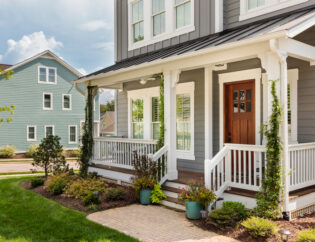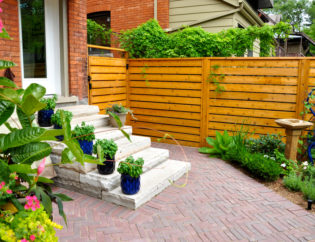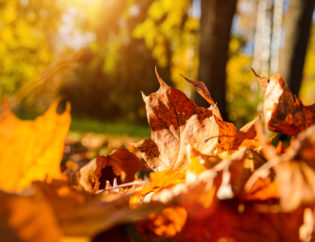
If you’re considering adding landscape lighting to your property, you’ve probably asked yourself, where to place landscape lighting for maximum effect. The good news is, there’s a multitude of approaches. This article covers everything you need to know about where to place landscape lighting to enhance the charm, safety, and ambiance of your home after dark. EMC Lawncare can provide landscape lighting installations in Bucks County and surrounding areas, give us a call today!
Why You Should Consider Landscape Lighting
Think of your favorite outdoor space. Now, envision that space bathed in a warm, inviting glow. That’s the magic of landscape lighting.
But its power goes beyond aesthetics. Landscape lighting accentuates the architectural features of your home, boosting curb appeal, and providing a safe and secure environment for you and your guests after the sun goes down.
Key Principles of Landscape Lighting Placement
There’s a reason why some outdoor spaces just seem to “work” at night. It’s often because of a keen understanding of basic lighting design.
To guide your lighting placement decisions, there are certain strategies you can use. Before you even begin deciding on specific placements, determine what effect you’d like to have based on the existing style of your landscape and yard. Consider adding string lights to your outdoor living space for a magical ambiance. Kings Outdoor Lighting offers a collection of low-voltage outdoor lights for just such an occasion.
Consider these strategies when figuring out where to place landscape lighting:
Highlighting
The highlighting technique uses lighting to draw attention to specific focal points in your landscaping you wish to showcase, such as a striking Japanese maple or an elegant statue.
The technique generally involves strategically placing a spotlight fixture near the base of the feature and angling the light to illuminate the chosen focal point. The effect this creates not only adds visual appeal but also dimension and drama to your yard.
Silhouetting
For creating dramatic effects, consider silhouetting. This technique involves placing a spotlight behind the subject – say, a tree or sculpture.
Aiming the light toward a nearby wall, for example, creates a dramatic, illuminated backdrop for the object, turning it into a silhouette. Imagine a majestic oak tree standing out against the soft glow of your house; that’s silhouetting in action. You can use solar lights for an eco-friendly option.
Shadowing
Similar to silhouetting, this technique involves strategically placing a fixture behind the feature, such as a grouping of ornamental grasses. The fixture is positioned in such a way as to cast interesting shadows of your feature onto a nearby wall or fence. This play of light and shadow adds depth and mystery to your outdoor space. This is especially effective during the evening hours, creating an enchanting atmosphere.
Uplighting
Adding drama and depth with a play between shadow and light on a building’s facade are two aspects of uplighting. This is achievable when spotlights are installed close to the bottom of the wall.
It results in a wash of light, emphasizing the unique aspects of the structure while adding dynamic variation. For a modern touch, consider smart lighting that you can control with your phone.
Downlighting
To recreate the serene ambiance of a moonlit night, opt for downlighting. It replicates natural light.
Achieved by placing light fixtures high up, in a tree, for example, you can create a soft glow illuminating the area below. This method subtly illuminates paths and features a soft glow from within the canopy of your trees, offering a lighting option reminiscent of the moon.
Path Lighting
Path lights, as their name implies, illuminate pathways and walkways, not just for aesthetics but safety. Place fixtures at intervals along your walkways. This will allow for even illumination.
Also, make sure your path lights are positioned to prevent glare. A well-lit path is not only aesthetically pleasing but creates a safe passage for visitors navigating your landscape at night. Well-placed lighting can also provide safety by deterring unwanted visitors.
Choosing the Right Fixtures
Not all outdoor lights are made equal, especially where power is concerned. When it comes to outdoor lighting, two common options exist – low-voltage lighting (12-volt) and line-voltage lighting (120-volt). It is important to note, the “voltage” refers to the operating voltage of these lights.
Low-Voltage Landscape Lighting
For energy efficiency and ease of installation, many people go for low-voltage options like 12-volt outdoor landscape lights. They’re also much safer to DIY, with their lower voltage and requirement to convert the power at the source. Lighting pathways with low-voltage options can create a welcoming atmosphere.
Line-Voltage Landscape Lighting
Line-voltage (typically 120-volt in the U.S.) is a great option if you’re going for maximum brightness. But a word of caution: these pack a punch, making them safer to leave in the hands of professionals. Line-voltage lights are especially well-suited to illuminate larger areas or highlight specific features.
Types of Lighting
When it comes to selecting the correct lighting type, consider this: each lighting style evokes a specific mood or serves a certain purpose within the overall landscape design. Consider these lighting options:
- Spotlights create focused beams, ideal for showcasing statues or trees.
- Well lights installed in the ground create an uplight effect and illuminate larger features like trees and architectural aspects.
- Wash lights offer broad, even coverage, making them ideal for illuminating large areas.
Learning where to place landscape lighting isn’t merely about illuminating the dark but about thoughtfully designing a nocturnal experience that elevates the beauty, safety, and functionality of your outdoor haven.










